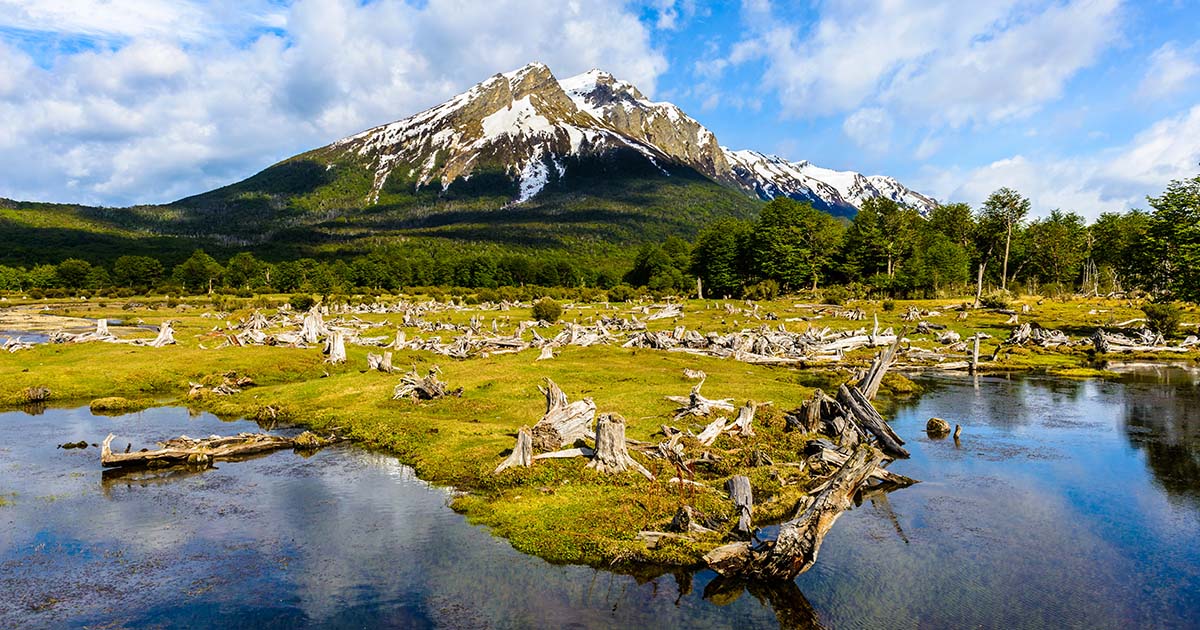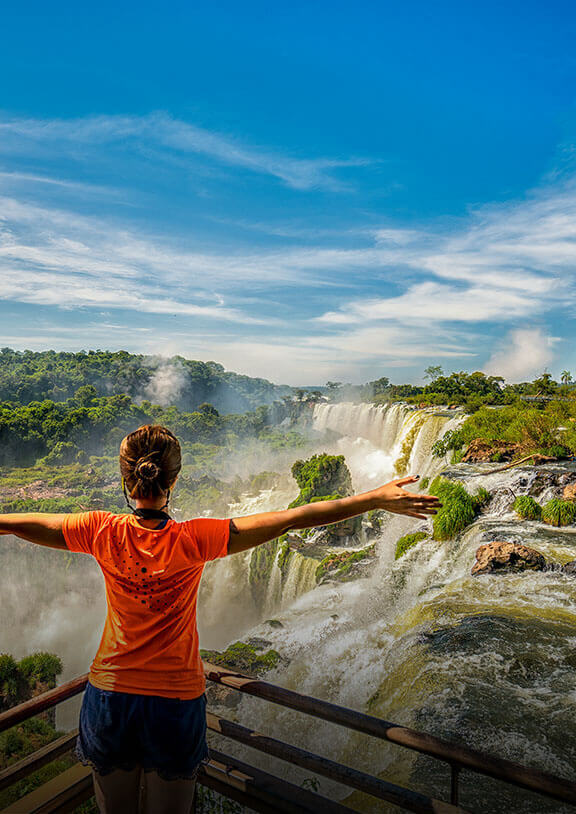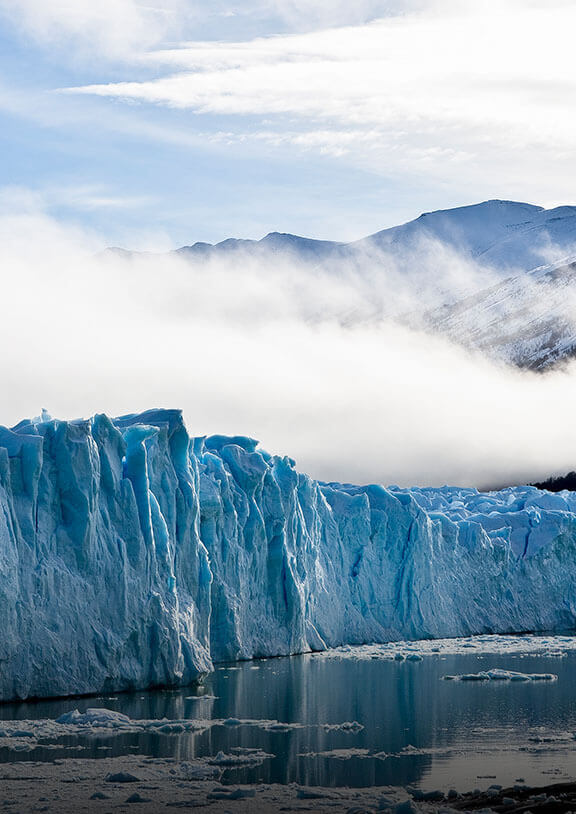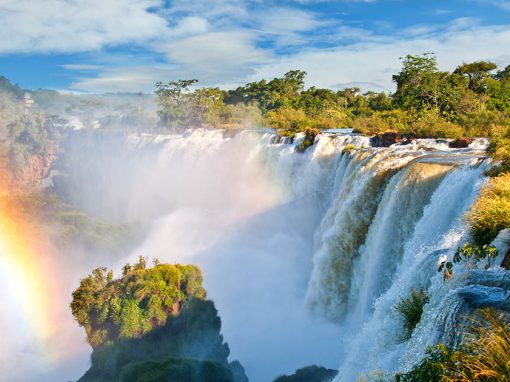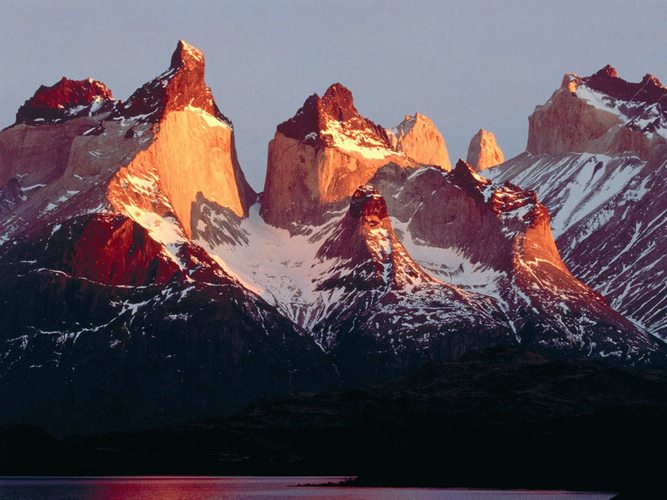Tierra del Fuego National Park, or Parque Nacional Tierra del Fuego, is Patagonia’s southernmost protected park and a UNESCO Heritage site. It is located on the Argentine side of the Tierra del Fuego Islands. Packed into a relatively small area, you will find picturesque landscapes and diverse animal species. This makes it a great destination for outdoorsy travelers. Keep reading for everything you need to know about visiting this wilderness at the end of the world.
Table of Contents
History of Tierra del Fuego National Park
Best Time to Visit Tierra del Fuego
Tierra del Fuego Tours & Activities
Tierra del Fuego Wildlife
How to Get to Tierra del Fuego National Park
Tierra del Fuego National Park Entrance Fee
Where to Stay
Tierra del Fuego Travel Tips
History of Tierra del Fuego National Park
After millennia of migration, humans made it to the most southern tip of the Americas about 10,000 years ago. Before the arrival of Europeans, the Yaghan (or Yámana) people inhabited the area. They lived off marine resources, protecting themselves from the harsh environment with sea lion pelts.
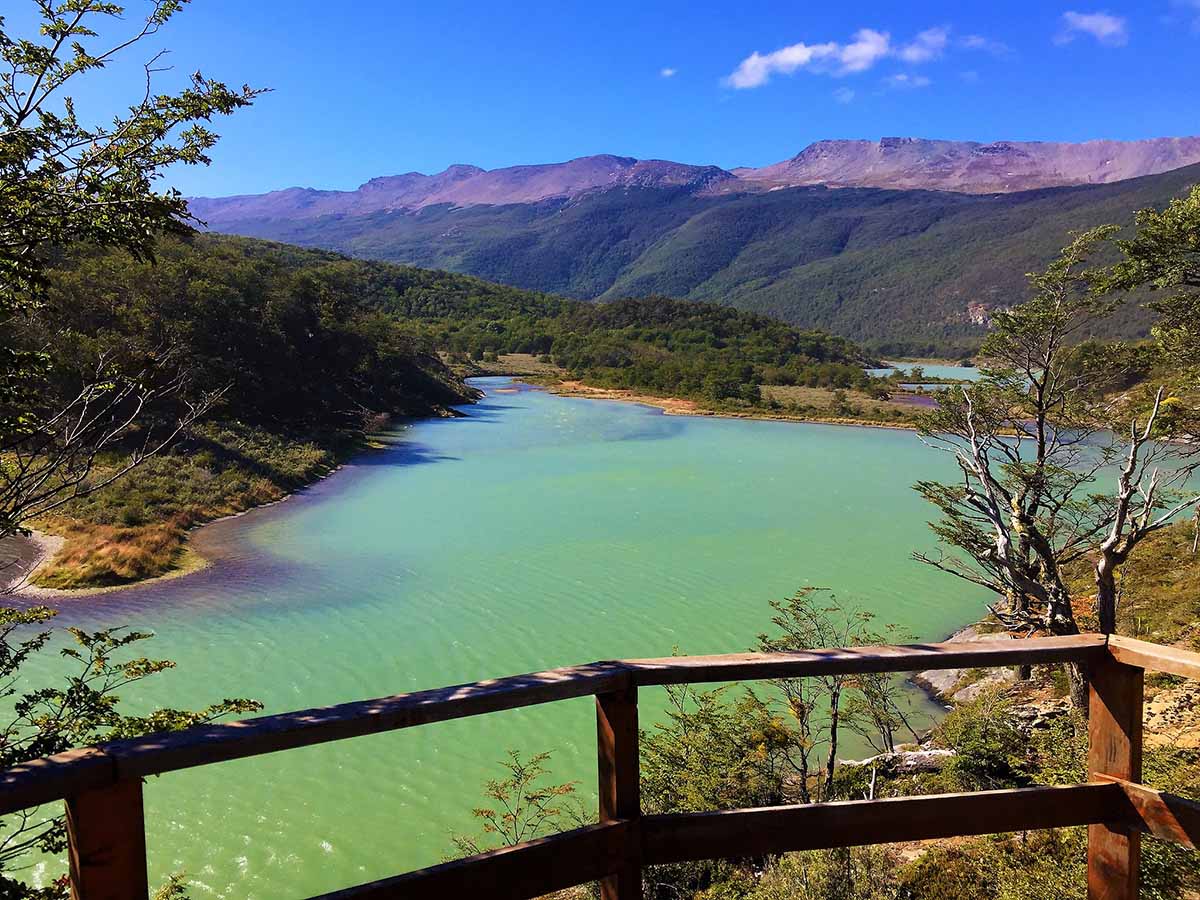
Enjoy the turquoise waters of Tierra del Fuego from a lookout point. Image: By Rodrigo Soldon / Used under CC BY-ND 2.0
When Europeans first navigated around the cape, they noticed the Yaghan people’s campfires. Thus the name Tierra del Fuego, or Land of Fire. In the 19th century, there came a rush of missionaries and gold prospectors. Of course, the arrival of so many outsiders severely diminished the Yaghan’s population.
Argentina declared its side of Tierra del Fuego a national park in 1960. It encompasses over 170,000 acres (68,000 hectares) of land. The park’s geography includes marine coasts, mountains, forests, peat bogs, lakes and glaciers. While the southern part of the park is accessible to visitors, most of the park is off-limits to protect the reserve.
Best Time to Visit Tierra del Fuego National Park
The best time of year to travel to Tierra del Fuego is during the summer months from December to February. This is when the days will be warmest and longest (up to 17 hours) and most activities are available. But anytime from October to April will still have good weather. Summer is also when animals are most active.
Cruise season also falls along the summer months from November to March. The peak season for departures is January through February. Anyone stopping in Ushuaia’s port for a few days can make the trip into the national park.
There are still some activities available during the winter, though. Skiing, of course, is a popular one. Winter is also better for scuba diving. Although the water will be much colder, calmer waters mean better visibility. Just remember that being so far south means very few hours of daylight this time of year — as little as seven! Read more about the best time to visit Patagonia.
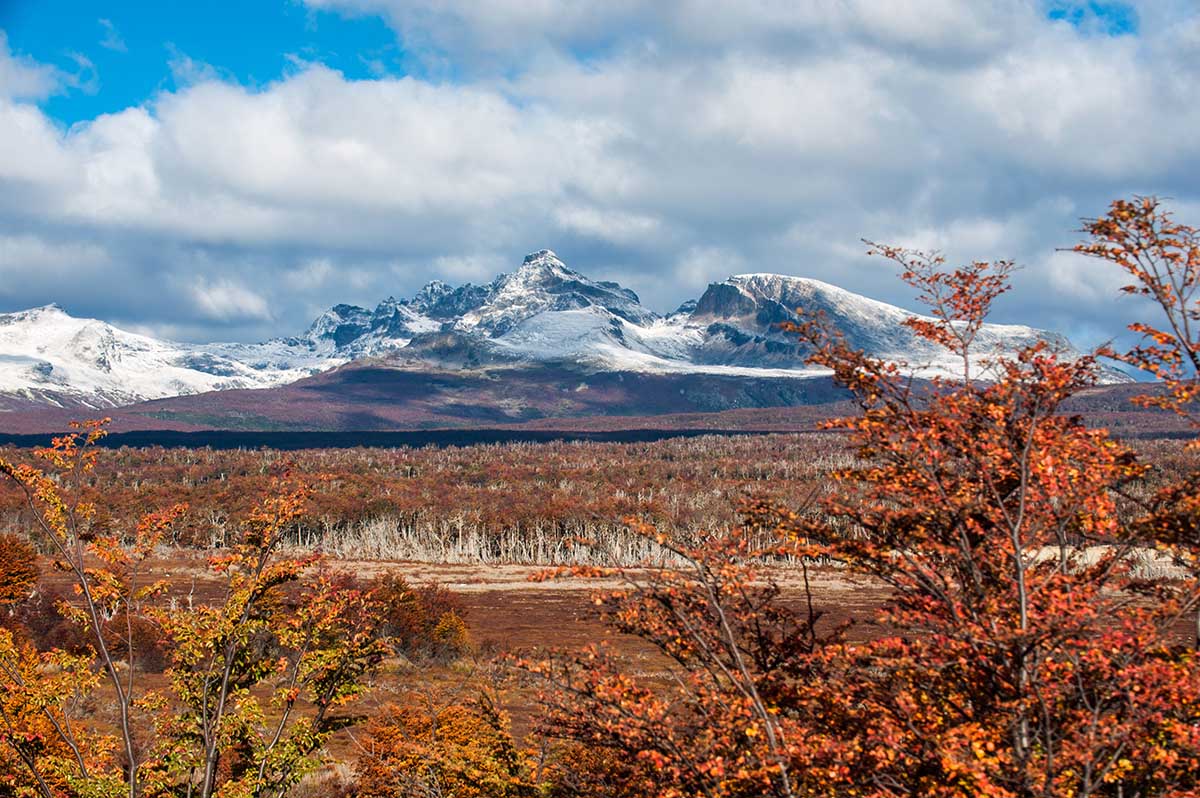
The fall colors in Tierra del Fuego are worth the chilly weather.
Although a stone’s throw from Antarctica, Tierra del Fuego’s climate is temperate albeit humid. Mixed with its coastal dampness, humidity also travels down with the southwestern winds. However, rain and snowfall are still low, ranging from 0.7 inches (17.8 mm) to 1.3 inches (32.7 mm) per month.
Summer months will see average daytime temperatures between 59ºF (15ºC) and 63ºF (17ºC). These months also have higher average wind speeds (12-15mph/20-24 km/h). Winter months have chilly but mild daytime temperatures from 43ºF (6ºC) to 46.5ºF (8ºC) and low wind speeds (9-11mph 15-17km/h).
Tierra del Fuego Tours & Activities
It’s easy to book a tour from Ushuaia or even tour Tierra del Fuego National Park on your own. The park offers a variety of outdoor activities for all ages and experience levels. With equal variety of scenery, you are sure to enjoy your time here.
Beagle Channel Navigation
The Beagle Channel got its name from the HMS Beagle that carried Charles Darwin on his famous expedition. It separates Isla Grande (large island) Tierra del Fuego from several smaller islands. Navigation tours will pass the edge of the national park along this historic straight to Les Eclaireurs lighthouse. With some luck, you can spot colonies of sea lions and penguins, as well as humpback and right whales.
Train of the End of the World & Museum
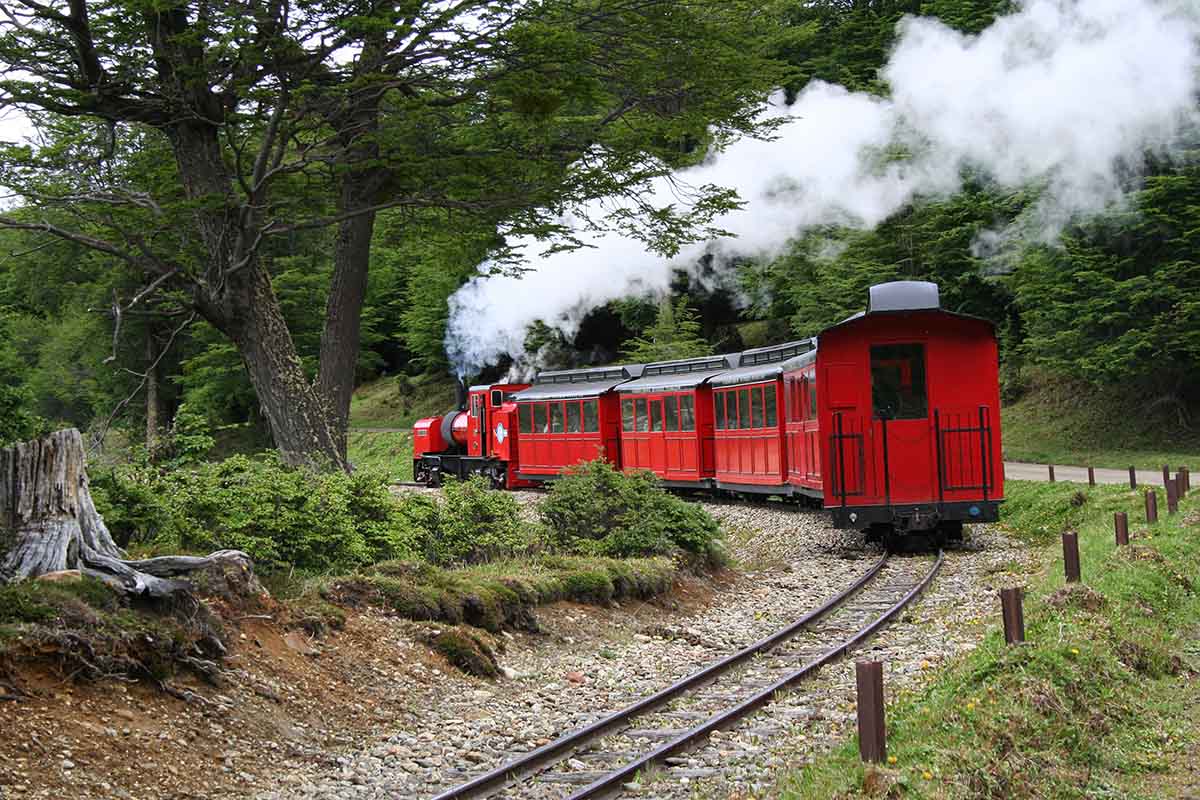
Ushuaia’s End of the World Train chugs along right through the beautiful scenery of the national park.
The Southern Fuegian Railway is a steam railway first used as a freight line for Ushuaia’s prison. After the prison closed in 1947, the line went unused for decades. Not until 1994 was the train revamped as a heritage railway. Now travelers can enjoy a comfortable ride through the national park.
There is also an End of the World Museum that showcases the varied history of Tierra del Fuego.
Hiking
With such varied and striking landscapes, hiking in Tierra del Fuego is a must when visiting.
Its network of 25 miles (40 km) of trails has hiking opportunities for all levels. Trails within the park are also well marked for effortless navigating. The best trekking conditions are from October to April.
Popular and easy trails include Mirador Lapataia, Laguna Negra and the Peat Bog hike. For more of a challenge, try the Pampa Alta trail that looks out over the Beagle Channel and Pipo River Valley. However, seasoned hikers may prefer the rugged trail that leads to the peak of Cerro Guanaco.
Note that the Cerro Guanaco and Andorra-Oveja trails both require registration ahead of time. First, you must go to the park’s administration in Ushuaia (Avenida San Martin) and then to the Alakush visitor’s center inside the park.
Also, keep in mind that almost all trails are closed during the winter months. The only exception is the Lapataia Bay trail.
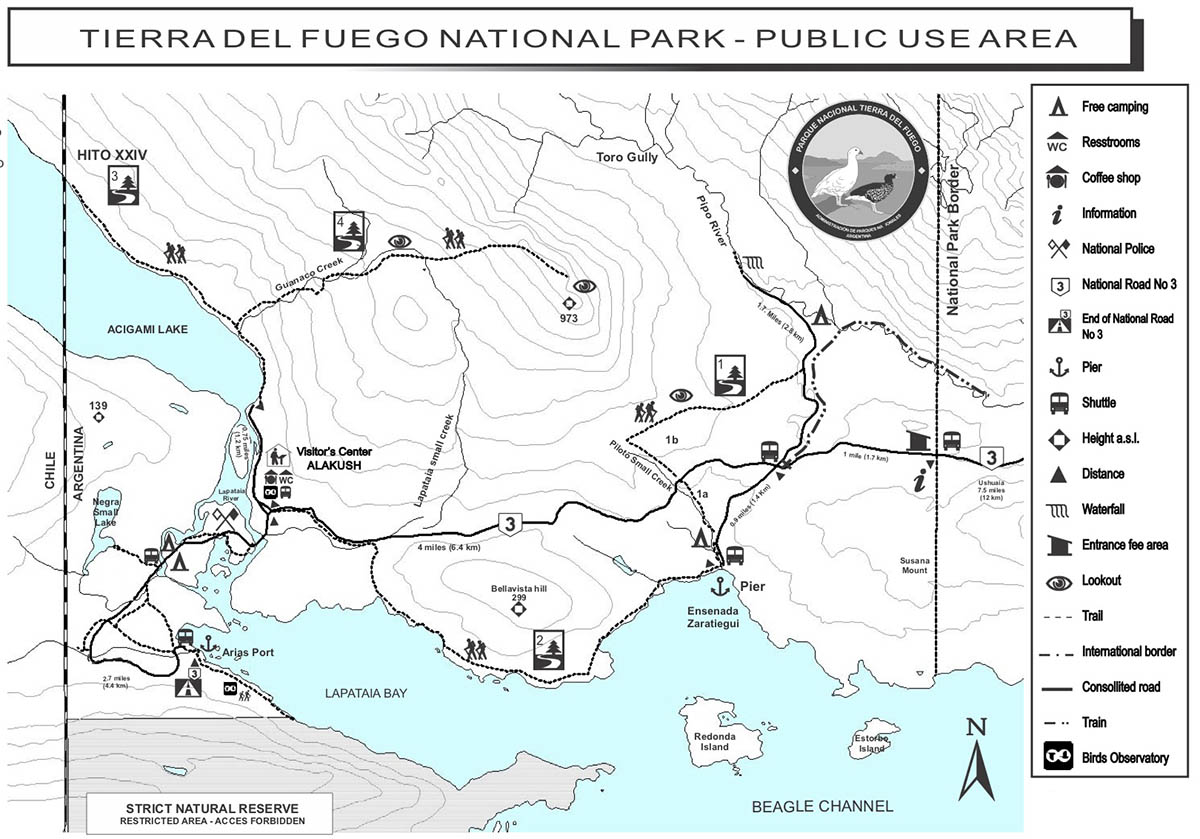
Hiking trails are marked on this helpful Tierra del Fuego National Park map from Ushuaia’s tourism center. With the collaboration of the Secretary of Tourism and Ushuaia municipality.
Canoeing
Rest your legs and pick up an oar to explore the park’s lakes and rivers. You can canoe on Acigami and Roca Lakes or down the Lapataia and Ovando Rivers. Along the banks, you may even sight some Tierra del Fuego animals.
Birding
The birds of Tierra del Fuego National Park come in many shapes, sizes and colors. Because of the park’s protected status, it offers a pristine environment for many species. With some quiet patience, you can spot intriguing birds like the Magellanic woodpecker, flightless steamer duck, austral pygmy owl, austral parakeet and fire-eyed diucon.
Camping
The national park has many campsites that are free to use for all visitors. The Pipo River, Ensenada Bay, Laguna Verde and Cauquenes campsites have bathrooms available from November to April. The Laguna del Caminante campsite on the Andorra-Oveja trail, however, does not have any facilities.
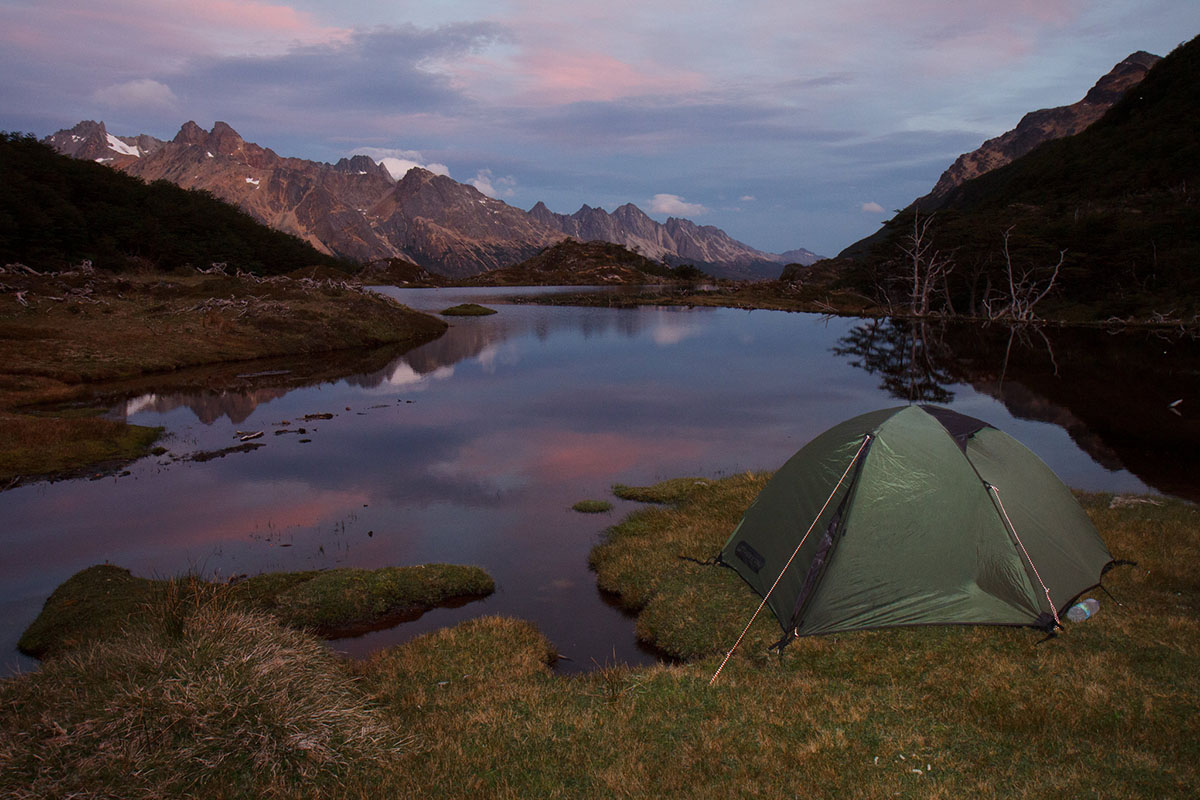
There are free campsites available inside the Tierra del Fuego National Park. Image: By Petr Meissner / Used under CC BY 2.0
Because the park has strict rules to protect its ecosystems, campers should leave no trace of their stay. This means that you must pack up any trash you produce, avoid digging or changing the landscape to suit your tent, and only build a fire if necessary. Although a portable camping stove is preferred, you can build a fire using charcoal or commercial firewood rather than gathering wood from the park.
Tierra del Fuego Wildlife
There are a number of interesting animals in Tierra del Fuego. Some may be familiar to you — like beavers and gray foxes — while others will be new personal discoveries. Here is a list of some of the more exciting species you may see during your visit.
Guanaco
Guanacos are a camelid species native to South America. They strongly resemble their llama cousins. However, they are a bit smaller, have smaller and straighter ears, and only come in shades of brown and white.
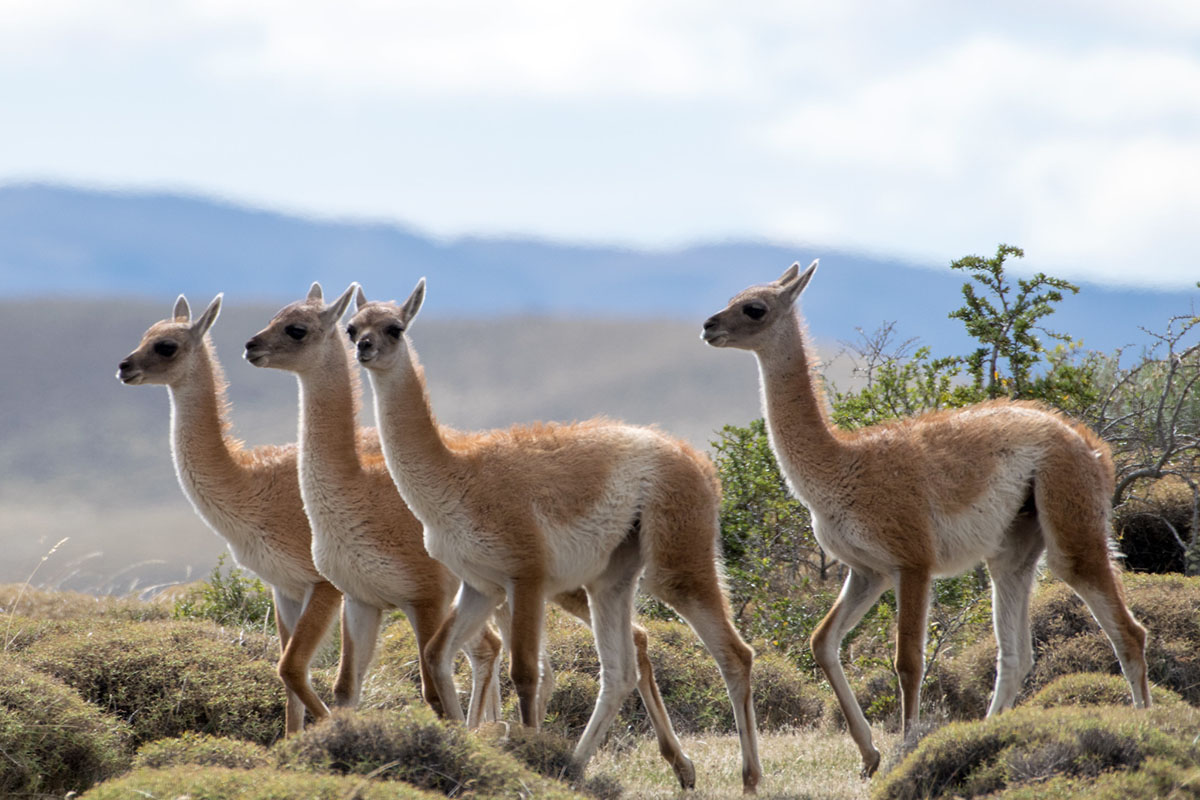
Guanacos are a close cousin of llamas and inhabit the southern part of the continent. Image: By Paul Asman and Jill Lenoble / Used under CC BY 2.0
South Andean deer
The south Andean deer, also known as the southern or Chilean guemal, is an endangered species native to Patagonia. Males have distinct black face markings and antlers that they shed each winter.
Andean fox
The Andean fox occupies a variety of ecosystems along South America’s western coast. Their coats are gray and reddish in color with a stripe down their backs. They are about the size of a red fox or coyote.
Southern river otter
Rather a misnomer, southern river otters enjoy both freshwater and marine environments. They are indigenous to southern Chile and Argentina. Due to habitat loss and illegal hunting, they have become an endangered species.
North American Beaver
Travelers from the United States and Canada will instantly recognize this species and its dams along the park’s rivers. Foreign settlers to the region introduced the species. Unfortunately, it is considered invasive and has done significant damage to the region’s ecosystem.
South American sea lions
South American sea lions are the most lion-like of the many sea lion species. Males, who can weigh up to 770 pounds (350 kg), have large heads and well-developed manes.
Penguins
Tierra del Fuego is home to several penguin species. The most notable are the Magellanic, Gentoo and king penguins.
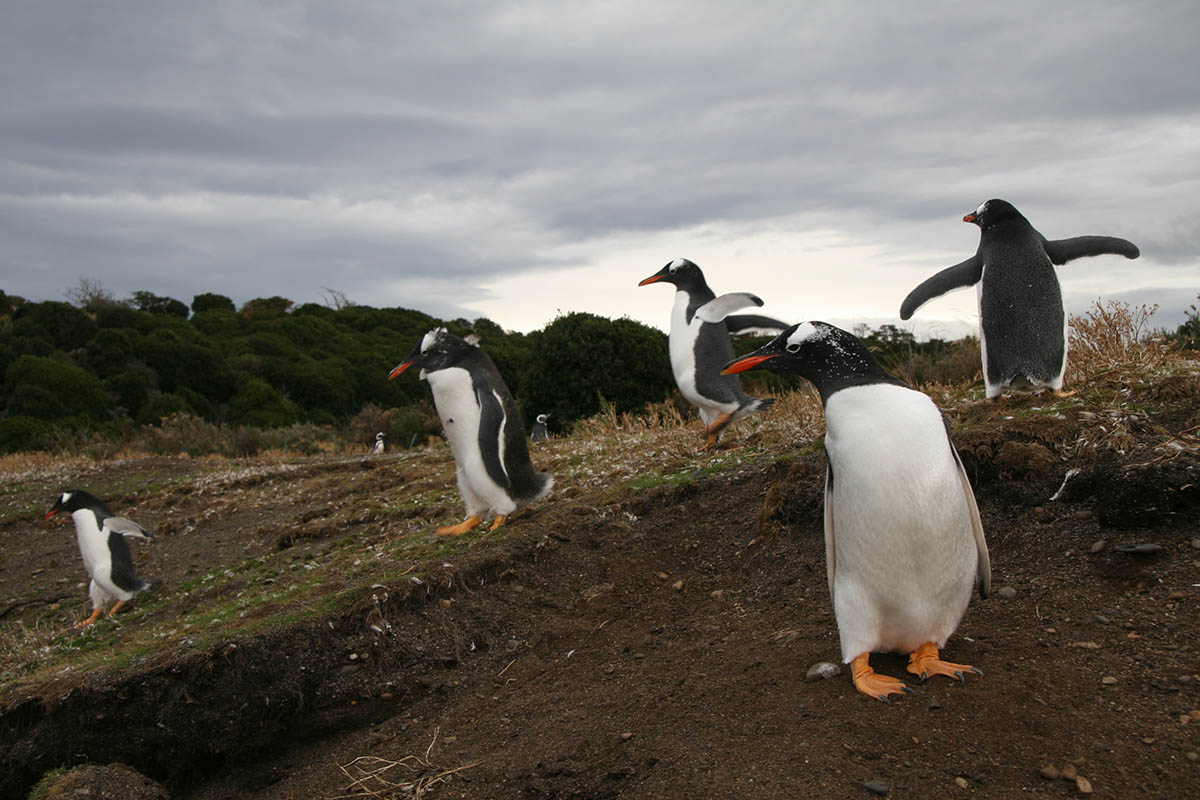
Gentoo penguins are just one of the penguin species that call Tierra del Fuego home.
Kelp goose
As the name suggests, this geese species’ diet largely consists of kelp. Because of this, they live around rocky coasts of Chile’s southern Patagonia, Tierra del Fuego and the Falkland Islands. Males are snowy white while females are dark brown with gray, horizontal stripes.
Austral parakeet
Austral parakeets, also known as emerald parakeets, live further south than any other species of parrot. You’ll most often find them in wooded areas in groups of 10 to 15.
Andean condor
The Andean condor is a New World vulture and the largest flying bird in the world. They glide through the valleys of Tierra del Fuego.
Magellanic woodpecker
Magellanic woodpeckers are only found in southern Chile and Argentina. A large species, the males’ heads are a striking red color. Both males and females have a tuft of feathers on top of their heads.
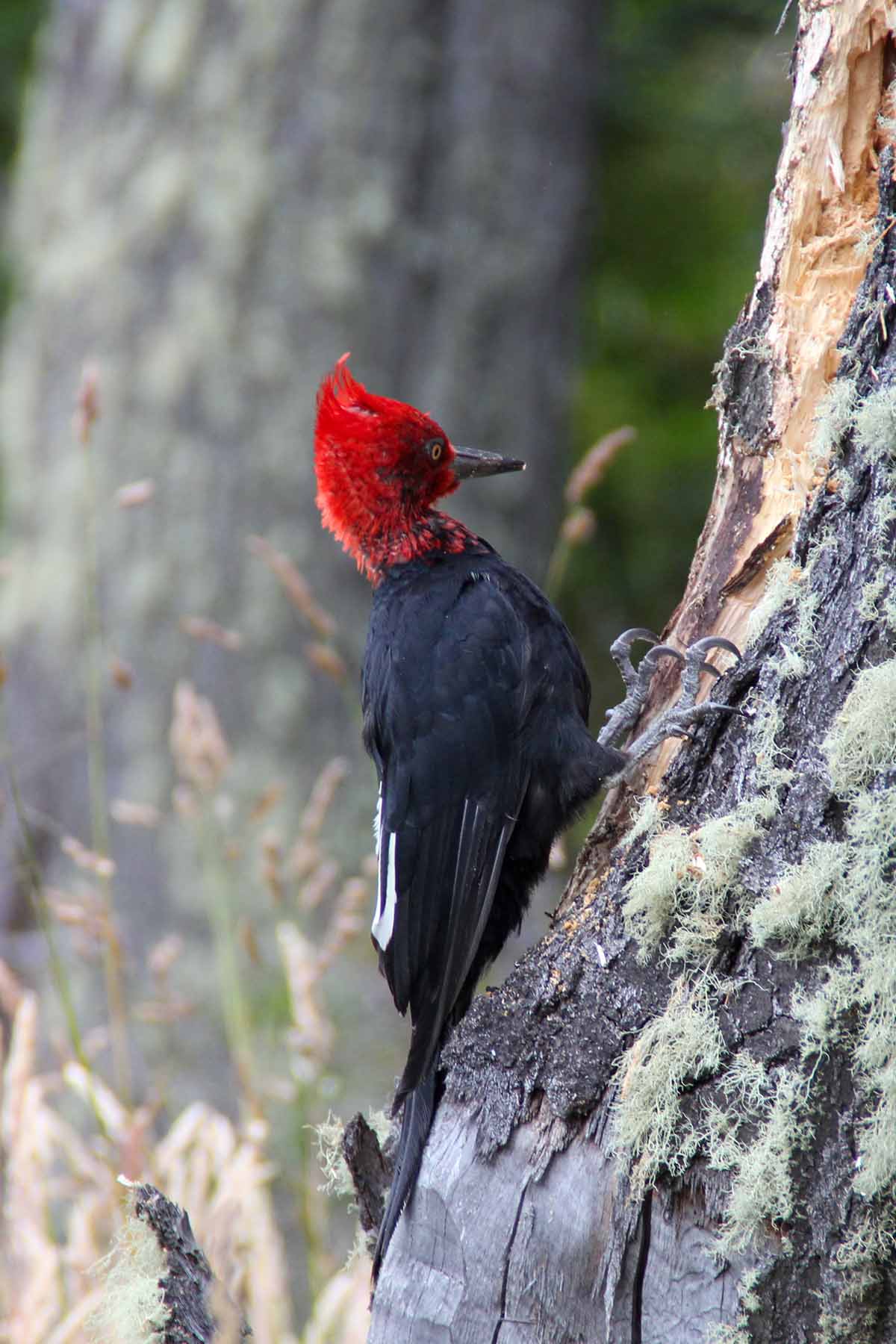
Male Magellanic woodpeckers have bright red heads while females are all black. Image: By Jaume Galofré on Unsplash.
Greenbacked firecrown hummingbird
This hummingbird species is found in the south of Chile and Argentina. Their “crown” of feathers have striking shades of yellow, oranges and reds. Like only a handful of other hummingbird species, they hang from flowers with their feet.
How to Get to Tierra del Fuego National Park
The park is located a short 7.5 miles (12 km) from the town of Ushuaia.
The local highway, National Route 3, takes you straight there so driving to Tierra del Fuego National Park from Ushuaia is very easy. With the local speed limit, you will arrive in 20 minutes. If you are renting a car, there is plenty of parking at the entrance. You can also hire a taxi. Just be sure to arrange a time for them to pick you up since taxis won’t be readily available at the entrance.
Another option is to take a shuttle bus from Ushuaia. These shuttles run almost hourly from the bus station at the intersection of Avenida Maipu and Juana Genoveva Fadul. You can buy a ticket at a small booth within the station or even arrange bus tickets with your hotel.
But perhaps the easiest way to get there is to arrange a tour. Your Travel Advisor can take care of all the logistics for you ahead of time so all you need to do is enjoy your time.
Tierra del Fuego National Park Entrance Fee
Depending on what time of year you visit the park, you may need to pay an entrance fee. During the off-season from May 1st to September 30th entrance to the park is free.
However, starting on October 1st, the first day of the high season, these are the entry prices:
- General admission: 560.00 Argentine pesos (US $7.00)
- Children from 6 to 12 year-olds: 90.00 Argentine pesos (US $1.10)
- Children under 6 years old: free
If you visit on a second consecutive day, your admission is 50 percent off.
Where to Stay
Unless you enjoy camping, you won’t be able to stay in the national park itself. Instead, the best place to stay is in the nearest town, Ushuaia. Located at the southernmost tip of South America, Ushuaia is known as the town at the “End of the World.” It serves as the gateway to Tierra del Fuego National Park for those arriving by air or by sea.
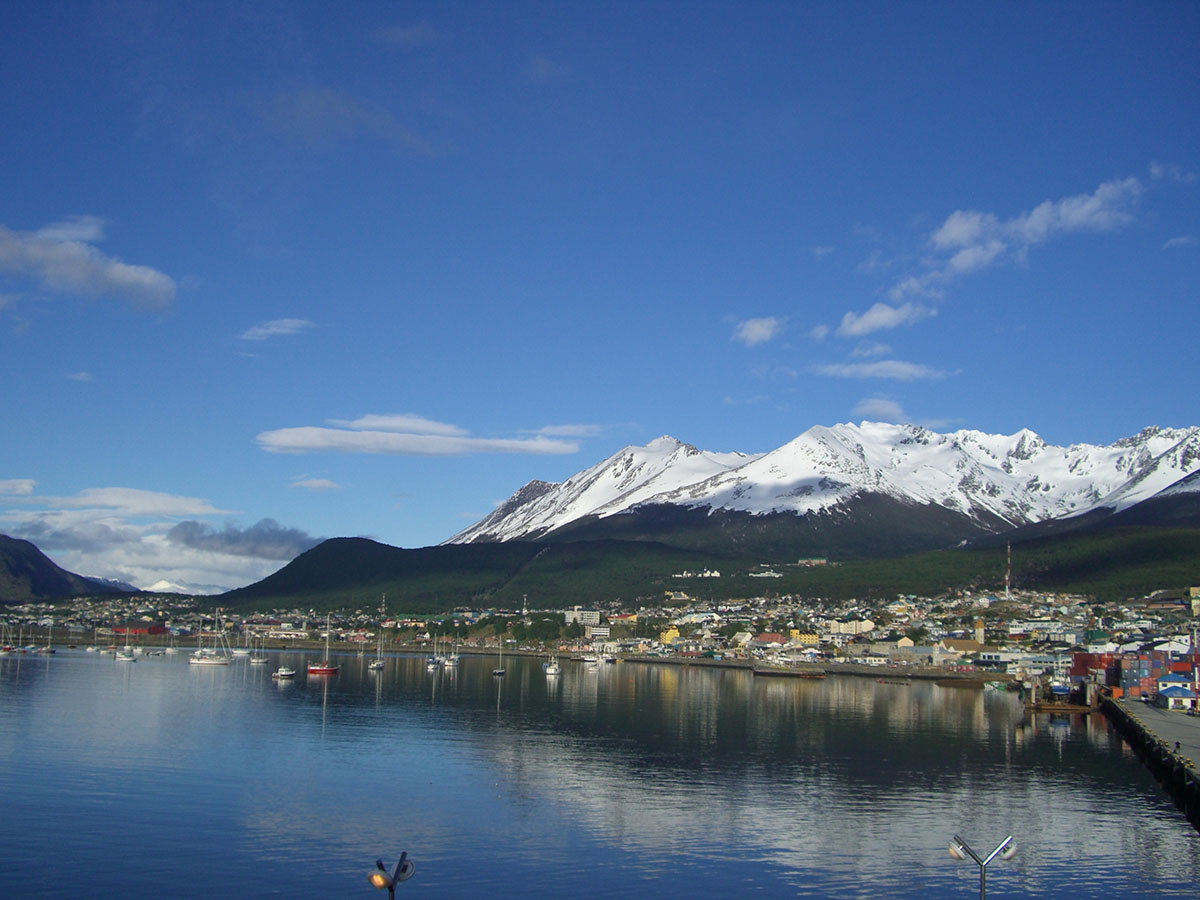
Ushuaia, the town at the End of the World, sits in front of the Beagle Channel and at the foothills of Tierra del Fuego’s mountains.
Below are the best hotels in Ushuaia for all travel preferences and budgets.
Los Cauquenes Resort & Spa (5-star)
The lacquered wood exterior and surrounding evergreens give Los Cauquenes a rustic, ski retreat vibe. Stepping inside, you’ll find modern touches that complement the familiarness of the warm wood finishings. The resort has a privileged view over the bay that you can take in from your warmly appointed room, the glass-enclosed lounge or an outdoor jacuzzi. During your downtime, you can walk along the beach, enjoy a fine dining experience or get a well-earned massage after a long day of hiking.
Las Hayas Ushuaia Resort (5-star)
For those looking for somewhere more secluded, Las Hayas Resort is the perfect 5-star option. During the winter months, it’s one of the best hotels for skiers since it is located at the base of Cerro Castor and has its own ski lodge. After spending the day winding down the slopes, you can wind down on a massage table or in the sauna.
Cilene del Faro Suites & Spa (4-star)
Cilene del Faro is conveniently located half a block from Avenida Maipu, one of Ushuaia’s main avenues that runs along the bay. Independent travelers will appreciate the homey feel of their own living room, kitchenette and breakfast bar in one of the hotel’s apartments. There are also a variety of rooms in classic neutral shades or with splashes of inviting colors. Just be sure to reserve an ocean view room…for obvious reasons.
Alto Andino (4-star)
Alto Andino’s restaurant has perhaps one of the best views in town. Catch vivid sunset colors over Ushuaia’s bay from the top floor’s panoramic windows as you enjoy an evening meal or nightcap. Rooms are bright and neatly appointed. There is also the option to reserve one of the hotel’s apartments, equipped with a kitchenette, living room and a separate bedroom.
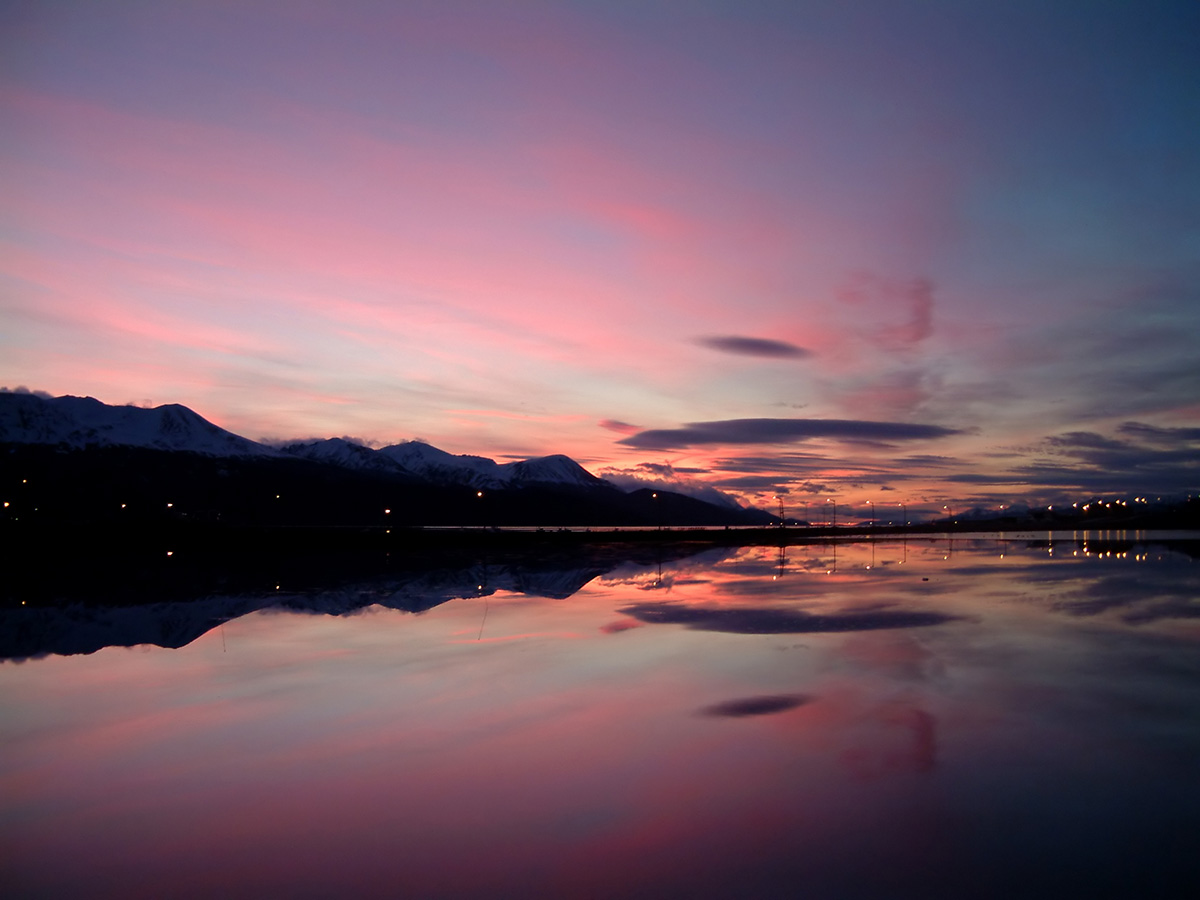
Depending on the time of year, sunsets in Ushuaia can be as early as 5 p.m. or as late as 10 p.m.
Patagonia Jarke Hosteria (3-star)
Patagonia Jarke makes a wonderful first impression the moment you walk up to its front doors. Its architecture is reminiscent of a ski lodge tucked away in a remote corner of the Swiss Alps, with wood paneling and criss-cross designs framing its windows. Rooms are simple but inviting with clean gray comforters, warm, neutral finishes and just the right amount of floral print.
Hostería Tierra de Leyendas (boutique)
There’s something a little bit magical about Tierra de Leyendas. Its style is unique, with its iron-framed furniture, scattered plants and books, and linens borrowed straight from a fairytale cottage. It may not have spa services or a pool, but you’ll feel instantly at home here. Dine on regional products at their restaurant, enjoy a drink or two during happy hour, or hunker down by the firepit with a maté (traditional Argentinian green tea).
Tierra del Fuego Travel Tips
- Hiking trails within the national park are well marked so it would be difficult to get lost. It’s always a good idea, though, to let others know what your plans are and what time they should expect you to be back at your hotel or accommodations.
- Stay hydrated while out doing vigorous activities.
- Wear comfortable athletic clothes and a good pair of hiking boots or sneakers. Even if you plan on doing easy hikes, a good tread will keep you from falling on slick trails.
- Pack extra layers in your daypack. There’s always a chilly wind in Tierra del Fuego and the weather can change rapidly. Bring warm layers in case you’re out longer than you plan, as well as waterproof layers in case of rain.
- Pack sunscreen, hats and sunglasses. You may be an extreme southern latitude, but that’s no excuse to not protect yourself from the sun’s rays!
- Whatever you bring into the park, be sure to bring back out. This includes personal belongings, food and trash.
- Animal photography enthusiasts should plan on bringing a zoom lens to get stunning photos of Tierra del Fuego’s native animals without needing to get too close.
- Travelers — and especially birders — should pack binoculars to spot unique species of birds in the southern Patagonian forests, lakes and mountaintops.
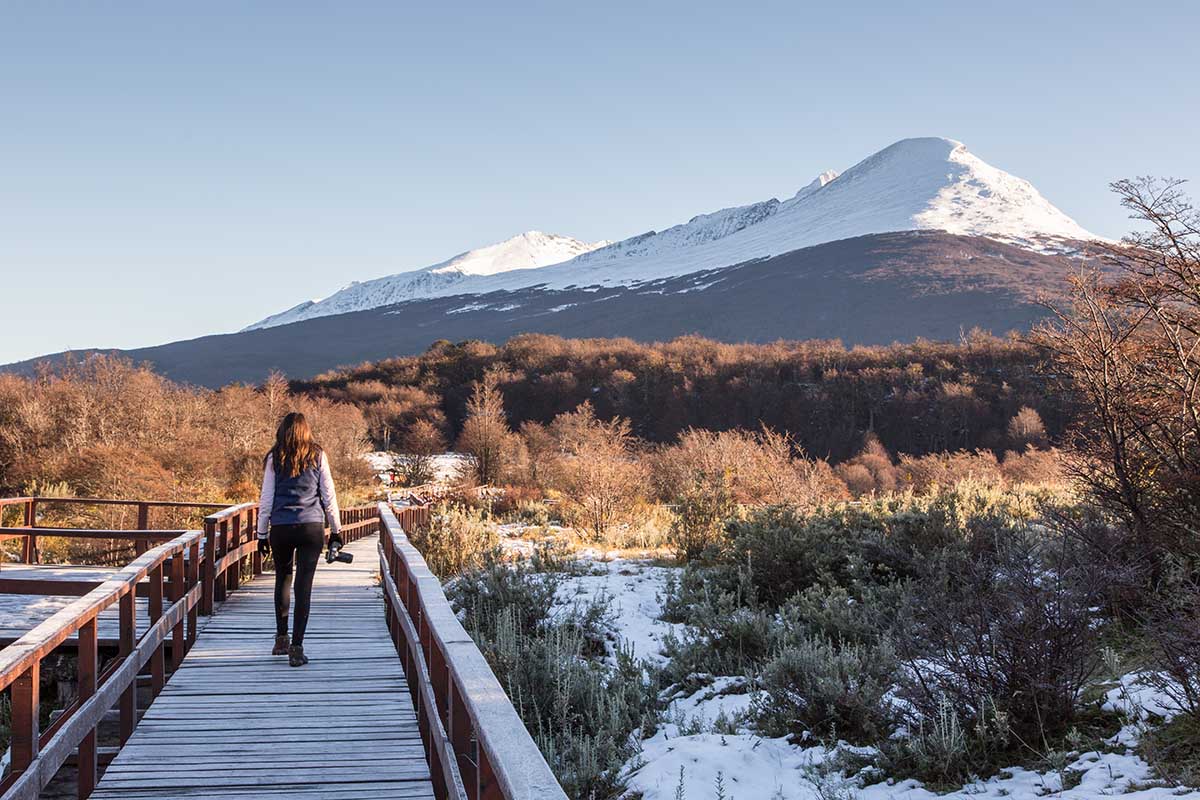
Few tourists are out exploring the park during the off-season months in late fall and winter.
For those looking for faraway natural beauty and adventure, it’s well worth taking a trip to the End of the World. The care taken to protect Tierra del Fuego National Park ensures that there are wildlife and wonders for everyone to enjoy.
Ready to explore the far reaches of the earth? Contact us to plan the perfect trip to Tierra del Fuego and beyond!
A love of foreign languages brought Rachel diving headfirst into that expat life. She has spent the last few years living in Peru, exploring both touristy and off-the-beaten-path destinations throughout the country. Some of her favorite things to do in Peru are hiking, visiting museums, and trying veggie-friendly versions of typical Peruvian dishes.

